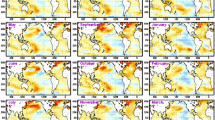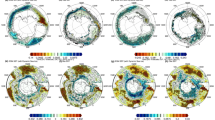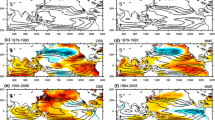Abstract
Skill for initialized decadal predictions for atmospheric and terrestrial variability is posited to reside in successful prediction of sea surface temperatures (SSTs) associated with the low-frequency modes of coupled ocean–atmosphere variability, for example, Pacific Decadal Oscillation (PDO) or Atlantic Multi-decadal Oscillation (AMO). So far, assessments of the skill of atmospheric and terrestrial variability in decadal predictions, however, have not been encouraging. Similarly, in the context of seasonal climate variability, teleconnections between SSTs associated with PDO and AMO and terrestrial climate have also been noted, but the same SST information used in predictive mode has failed to demonstrate convincing gains in skill. Are these results an artifact of model biases, or more a consequence of some fundamental property of coupled evolution of ocean–atmosphere system in extratropical latitudes, and the manner in which extratropical SST anomalies modulate (or constrain) atmospheric variability? Based on revisiting an analysis of a simple model that replicates the essential characteristics of coupled ocean–atmosphere interaction in extratropical latitudes, it is demonstrated that lack of additional skill in predicting atmospheric and terrestrial variability is more a consequence of fundamental characteristics of coupled evolution of ocean–atmosphere system. The results based on simple models are also substantiated following an analysis of a set of seasonal hindcasts with a fully coupled model.









Similar content being viewed by others
References
Barnett TP, Arpe K, Bengtsson L, Ji M, Kumar A (1997) Potential predictability and AMIP implications of midlatitude climate variability in two general circulation models. J Clim 10:2321–2329
Barsugli JJ, Battisti DS (1998) The basic effects of atmosphere-ocean thermal coupling on midlatitude variability. J Atmos Sci 55:477–493
Branstator G, Teng H (2010) Two limits of initial-value decadal predictability in a CGCM. J Clim 23:6292–6311
Bretherton CS, Battisti DS (2000) An interpretation of the results from atmospheric general circulation models forced by the time history of the observed sea surface temperature distribution. Geophys Res Lett 27:767–770
Chen M, Wang W, Kumar A, Wang H, Jha B (2012) Ocean surface impacts on the seasonal precipitation over the tropical Indian Ocean. J Clim 25:3566–3582
Chen M, Wang W, Kumar A (2013) Lagged ensembles, forecast configuration, and seasonal predictions. Mon Weather Rev 141:3477–3497
Dai A (2013) The influence of the inter-decadal Pacific oscillation on US precipitation during 1923–2010. Clim Dyn. doi:10.1007/s00382-012-1446-5
Davis RE (1976) Predictability of sea surface temperature and sea level pressure anomalies over the North Pacific Ocean. J Phys Oceanogr 6:249–266
Doblas-Reyes FJ et al (2013) Initialized near-term regional climate change prediction. Nat Commun. doi:10.1038/ncomms2704
Frankignoul C, Hasselmann K (1977) Stochastic climate models. Part II: application to SST anomalies and thermocline variability. Tellus 29:289–305
Gershunov A, Barnett TP (1998) Interdecadal modulation of ENSO teleconnections. Bull Amer Meteor Soc 79:2715–2725
Goddard L et al (2013) A verification framework for interannual-to-decadal predictions experiments. Clim Dyn 40:245–272
Guztler DS, Kann DM, Thornbrugh C (2002) Modulation of ENSO-based long-lead outlooks of southwestern U.S. Winter Precipitation by the Pacific Decadal Oscillation. J Clim 17:1163–1172
Hoerling MP, Kumar A, Xu T-Y (2001) Robustness of the nonlinear climate response to ENSO’s extreme cases. J Clim 14:1277–1293
Kim H-M, Webster PJ, Curry JA (2012) Evaluation of short-term climate change prediction in multi-model CMIP5 decadal hindcasts. Geophys Res Lett 39:L10701. doi:10.1029/2012GL051644
Kumar A, Hoerling MP (2000) Analysis of a conceptual model of seasonal climate variability and implications for seasonal predictions. Bull Amer Meteor Soc 81:255–264
Kumar A et al (2012) An analysis of the non-stationarity in the bias of sea surface temperature forecasts for the NCEP climate forecast system (CFS) version 2. Mon Weather Rev 140:3003–3016
Kumar A, Wang H, Wang W, Xue Y, Hu Z-Z (2013) Does knowing the oceanic PDO phase help predict the atmospheric anomalies in subsequent months? J Clim 26:1268–1285
MacLeod DA, Caminade C, Morse AP (2012) Useful decadal climate prediction at regional scales? A look at the ENSEMBLES stream 2 decadal hindcasts. Environ Res Lett 7:044012. doi:10.1088/1748-9326/7/4/044012
Meehl GA, Hu A (2006) Megadroughts in the Indian monsoon region and southwest North America and a mechanism for associated multidecadal Pacific sea surface temperature anomalies. J Clim 19:1605–1623
Meehl GA, et al (2013) Decadal climate prediction: an update from the trenches. Bull Amer Meteo Soc. doi:10.1175/BAMS-D-12-00241.1
Mills CM, Walsh JE (2013) Seasonal variation and spatial patterns of the atmospheric component of the pacific decadal oscillation. J Clim 26:1575–1594
Muller WA et al (2012) Forecast skill of multi-year seasonal means in the decadal prediction system of the Max Planck Institute for Meteorology. Geophys Rea Lett 39:L22707. doi:10.1029/2012GL053326
Peng P, Kumar A, Wang W (2011) An analysis of seasonal predictability in coupled model forecasts. Clim Dyn 36:419–430
Phelps MW, Kumar A, O’Brien JJ (2004) Potential predictability in the NCEP/CPC dynamical seasonal forecast system. J Clim 17:3775–3785
Pierce DW (2002) The role of sea surface temperatures in interactions between ENSO and the North Pacific Oscillation. J Clim 15:1295–1308
Saha S, et al (2014) The NCEP climate forecast system version 2. J Clim 27:2185–2208. doi:10.1175/JCLI-D-12-00823.1
Saha S et al (2006) The NCEP climate forecast system. J Clim 19:3483–3517
Soloman A et al (2011) Distinguishing the roles of natural and anthropogenically forced decadal climate variability: implications for prediction. Bull Amer Meteor Soc 92:141–155
Sutton RT, Dong B (2012) Atlantic Ocean influence on a shift in European climate in the 1990s. Nat Geosci 5:788–792. doi:10.1038/NGEO1595
Taylor KE, Stouffer RJ, Meehl GA (2012) An overview of CMIP5 and the experiment design. Bull Amer Meteor Soc 93:485–498. doi:10.1175/BAMS-D-11-00094.1
Teng H, Branstator G, Meehl GA (2011) Predictability of the Atlantic overturning circulation and associated surface patterns in two CCSM3 climate change ensemble experiments. J Clim 24:6054–6076
Trenberth EK, Branstrator GW, Karoly D, Kumar A, Lau N-C, Ropelewski C (1998) Progress during TOGA in understanding and modeling global teleconnections associated with tropical sea surface temperatures. J Geophys Res 107(C7):14291–14324
van Oldenborgh GJ, Doblas-Reyes FJ, Wouters B, Hazeleger W (2012) Decadal prediction skill in a multi-model ensemble. Clim Dyn 38:1263–1280
Wang H, Schubert S, Suarez M, Chen J, Hoerling M, Kumar A, Pegion P (2009) Attribution of the seasonality and regionality in climate trends over the United States during 1950–2000. J Clim 22:2571–2590
Wu R, Kirtman BP, Pegion K (2006) Local air–sea relationship in observations and model simulations. J Clim 19:4914–4932
Zhang R, Delworth TL (2006) Impact of Atlantic multidecadal oscillation on India/Sahel rainfall and Atlantic hurricanes. Geophys Res Lett 33:L17712. doi:10.1029/2006GL026267
Acknowledgments
Insigthful comments by Drs. Mingyue Chen and Peiteo Peng, and two anonymous reviewers are greatly appreciated. This study was supported by NOAA's Climate Program Office's Modeling, Analysis, Predictions, and Projections program.
Author information
Authors and Affiliations
Corresponding author
Rights and permissions
About this article
Cite this article
Kumar, A., Wang, H. On the potential of extratropical SST anomalies for improving climate predictions. Clim Dyn 44, 2557–2569 (2015). https://doi.org/10.1007/s00382-014-2398-8
Received:
Accepted:
Published:
Issue Date:
DOI: https://doi.org/10.1007/s00382-014-2398-8




